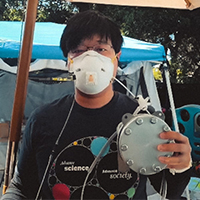A new type of protective face mask
In light of COVID-19 pandemic, research scientist John Xu and mechanical engineer Friedrich “Fritz” Prinz from Stanford University came together to rethink and improve protective face masks using their background in electrochemical processes.
As most of us are now familiar with, breathing with a face mask can be uncomfortable and difficult. According to Stanford News, that’s because N95 masks filter out 95 percent or more of small particulate matter from the air, including the virus, which as a result, makes breathing harder. Its estimated oxygen intake can be reduced anywhere from 5 to 20 percent which can lead to dizziness and lightheadedness. Particularly for health care workers and others working in the front lines of the pandemic, long-term mask wear can even damage lungs.
In order to combat the problem, Xu and Prinz came up with a new type of protective face mask that can counteract the side effects of oxygen deficiency. With the help of a small box that is worn at the waist and a tube that extends to the face mask, the device not only facilitates breathing but also generates clean, pure oxygen using an electrochemical process to supplement the loss of oxygen due to masking, says Xu.
Learn more about the science and work behind the modified N95 face mask.



